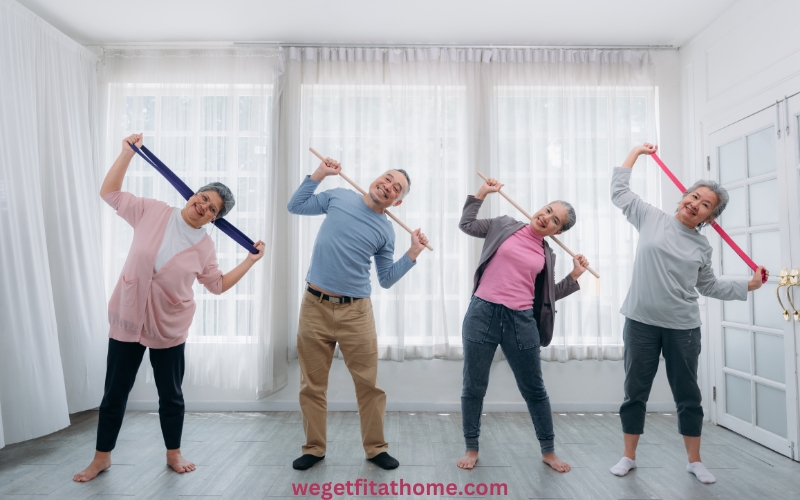Cardio, strength, balance, and stability exercises for seniors are functional exercises that are essential for older adults to maintain independence, mobility, and overall quality of life. They focus on movements that mimic daily activities, improving strength, balance, flexibility, and cardiovascular health.
In a Hurry Table:
This post contains affiliate links. If you click on and purchase through one of those links, you won’t pay a penny more, but we’ll get a small commission, which helps keep our website operating. Thanks! As an Amazon Associate, I earn from qualifying purchases.
Cardio, Strength, Balance, and Stability Exercises for Seniors
Listed below are four basic types of exercises that are particularly beneficial for older adults.
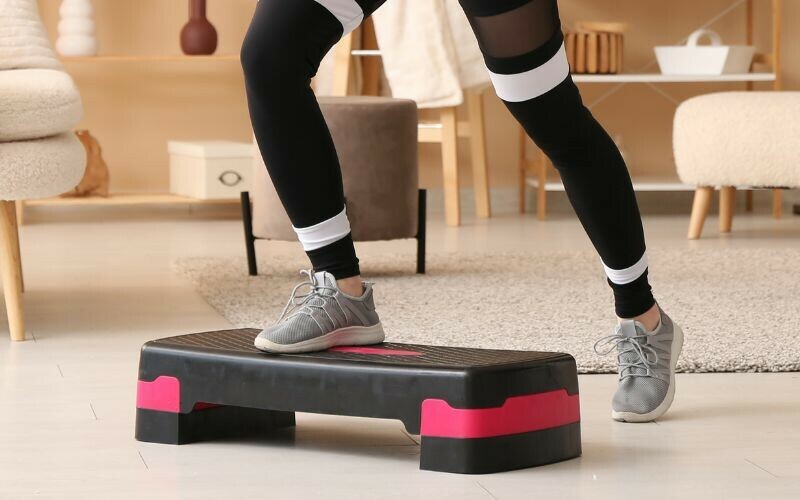
1. Aerobic (Cardiovascular) Exercises
Cardio exercise improves heart health, stamina, and energy levels. Aerobic exercise strengthens the heart and lungs and improves oxygen circulation throughout the body.
Cardio exercise increases your stamina. It also reduces the risk of chronic diseases like heart disease and diabetes, and boosts your overall energy levels. This makes it essential for maintaining an active and healthy lifestyle, especially for older adults.
Examples:
-
- Walking: A simple and effective way to improve cardiovascular health. It’s low-impact and you can do it almost anywhere.
- Swimming: Provides a full-body workout that is easy on the joints, making it ideal for older adults.
- Cycling: It doesn’t matter if you use a stationary bike or an outdoor bike, cycling helps improve heart health and leg strength.
Other home exercise equipment for aerobic exercises include:
- Treadmill: Allows for walking or running indoors with adjustable speed and incline settings.
- Stationary Bike: Low-impact cardio workouts are easy on your joints.
- Elliptical Trainer: Combines the motion of walking, running, and climbing for a low-impact cardio workout.
- Jump Rope: An affordable and effective tool for improving cardiovascular fitness and coordination.
These tools are great for aerobic workouts at home, building cardiovascular health and overall fitness.
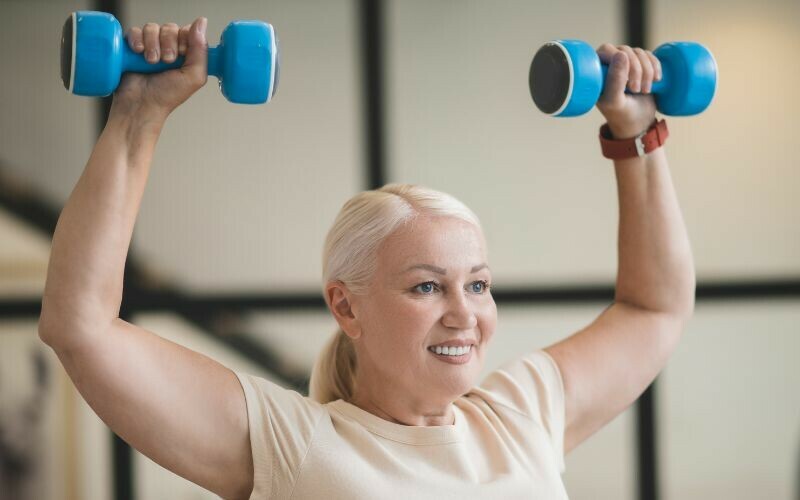
2. Resistance (Strength) Exercises
Strength training builds muscle mass, increases bone density, and boosts metabolism, which are crucial for maintaining physical independence as you age.
It helps prevent muscle loss, reduces the risk of osteoporosis, and enhances functional abilities like lifting, carrying, and climbing stairs. Thus, daily tasks are easier with improved overall quality of life.
Examples:
-
- Chair Squats: Strengthens the lower body muscles, particularly the quadriceps and glutes. Stand up from a seated position and sit back down without using your hands.
- Resistance Band Exercises: These are useful for a variety of exercises, such as bicep curls and seated rows, to build strength in the upper body.
- Wall Push-Ups: A modified push-up using a wall to strengthen the chest, shoulders, and arms.
Other home exercise equipment for strength exercises include:
- Dumbbells: Versatile weights used for various exercises targeting different muscle groups.
- Resistance Bands: Provide adjustable resistance for strength training without heavy weights.
- Kettlebells: Ideal for dynamic exercises that build strength and endurance.
- Pull-Up Bar: Enables bodyweight exercises like pull-ups and chin-ups to build upper body strength.
- Ankle Weights: Add resistance to leg exercises, such as leg lifts and glute bridges.
- Suspension Trainer (e.g., TRX): Uses body weight and gravity to perform a wide range of strength exercises.
These tools help create an effective strength training routine at home, targeting different muscle groups.
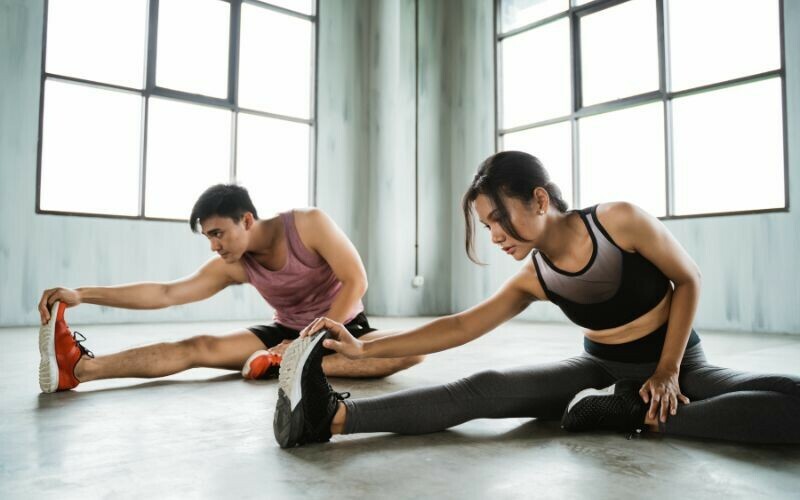
3. Flexibility Exercises
Flexibility exercises maintain and improve the range of motion in muscles and joints, reducing stiffness and the risk of injuries.
They help older adults perform daily activities with ease, such as bending, reaching, and twisting, while also alleviating muscle tension and enhancing posture, balance, and overall mobility.
Good flexibility is a major contributing factor to greater independence as you age.
Examples:
-
- Seated Hamstring Stretch: Sit on the edge of a chair, extend one leg, and reach toward your toes to stretch the hamstrings.
- Overhead Reach: While seated or standing, reach both arms above your head to stretch the upper body and improve shoulder flexibility.
- Neck Stretches: Slowly tilt your head side to side and forward and backward to gently stretch the neck muscles.
Other home exercise equipment for flexibility exercises include:
- Exercise Ball (Stability Ball): Stretch your back, chest, and core muscles, to enhance flexibility.
- Foam Roller: Used for self-myofascial release, helping to relieve muscle tightness and improve flexibility.
- Resistance Bands: Assist in deepening stretches and improving flexibility in the legs, arms, and shoulders.
- Stretching Straps: These help extend your reach during stretching. allowing for greater range of motion in various stretches.
- Yoga Mat: Provides a comfortable surface for stretching exercises and yoga routines.
These tools help make flexibility exercises more effective by allowing for deeper, more controlled stretches.
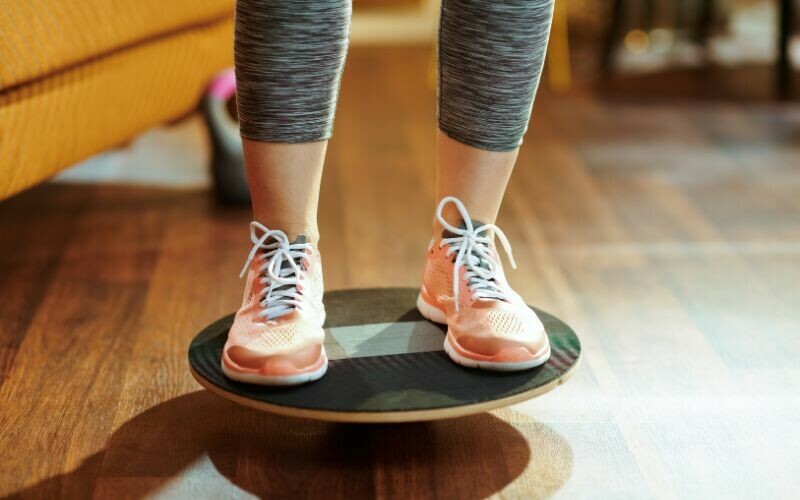
4. Balance Activities
Balance exercises enhance stability, coordination, and proprioception, reducing the risk of falls—a major concern for older adults.
They strengthen key muscles and improve posture, allowing for better control of body movements.
By maintaining and improving balance, these exercises help preserve independence and confidence in performing everyday activities safely.
Examples:
-
- Single-Leg Stand: Try standing on one leg while holding onto a sturdy chair or countertop for support. Gradually reduce the amount of support to improve balance.
- Heel-to-Toe Walk: Walk in a straight line, placing the heel of one foot directly in front of the toes of the other foot, as if walking on a tightrope.
- Tai Chi: This is a gentle form of exercise that involves slow, controlled movements. It is particularly effective for improving balance and coordination.
Other home exercise equipment for balance exercises include:
- Balance Boards/Wobble Boards: Challenge stability by requiring users to maintain balance on an unstable surface.
- Stability Balls: Seated or standing exercises improve your body’s core strength and natural balance.
- Resistance Bands: Used for exercises like leg lifts or lateral walks to engage stabilizing muscles.
Enhance your home workout routine with these balance and coordination tools.
Cardio, Strength, Balance, and Stability Exercises for Seniors
Looking to boost your fitness routine at home? Incorporate these four essential exercise types to target all aspects of your workout needs.
For the best results, older adults should aim to incorporate a mix of these exercises into their weekly routine. As an example, you can walk or swim three to five times per week. Two or three times a week is great for strength training and balance exercises. Include flexibility exercises in your daily routine to maintain a full range of motion.
Disclaimer: If you have any concerns or questions about your health, you should always consult with a physician or other healthcare professional. No content on this site should be substituted for direct medical advice from your doctor or other qualified healthcare practitioner. The information contained here is for informational purposes only. It is from my research and personal experience.
Related Articles
9 Best Balance Exercises for Older Adults
Can You Prevent Muscle Loss as You Age?
Tips for Gaining Muscle Mass after 50
Stretches Increase Flexibility: 7 Benefits of Stretching

